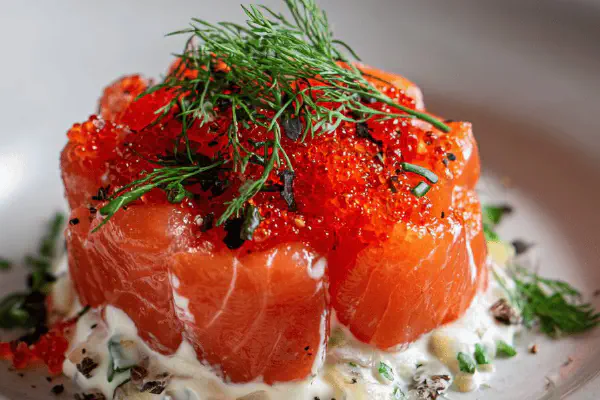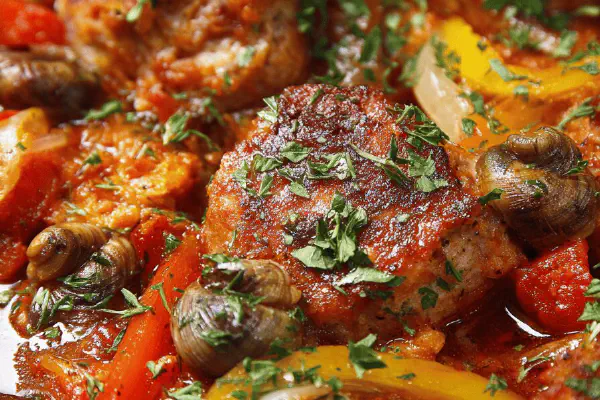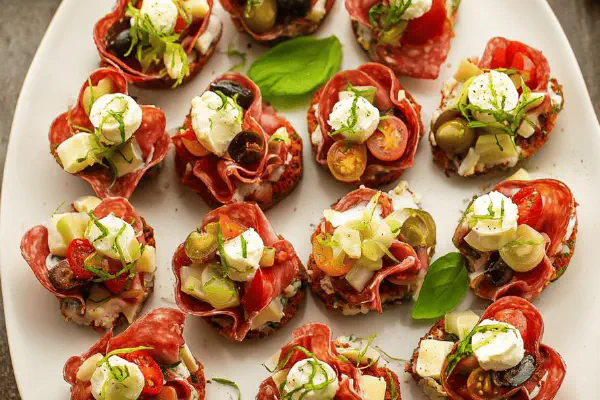Salmon Rosettes on Creamy Fennel

By Emma
Certified Culinary Professional
Ingredients
- 1 medium fennel bulb, trimmed (approx 300 g)
- 20 ml unsalted butter (1 1/3 tbsp)
- 125 ml crème fraîche (about 1/2 cup)
- 400 g fresh salmon fillet, skin removed
- Tobiko (flying fish roe), for garnish
- Fresh dill sprigs, roughly chopped
- Preserved lemon zest, finely minced
- Sea salt and freshly cracked black pepper, to taste
- 4 sheets parchment paper, about 12.5 cm square each
- Optional: 1 tsp lemon juice, if fennel too sweet
About the ingredients
Method
- Set an oven rack to middle position. Preheat oven to 210 °C (410 °F). Line baking tray with parchment squares.
- Reserve leafy fennel fronds for garnish later. Cut fennel bulb in half. Remove tough core by slicing vertically and popping out. Slice thinly — aim for near-transparent pieces for quick cooking, about 2 mm thick.
- In a medium pan over medium heat, melt butter until foaming but not browned (about 1 minute). Toss fennel slices in. You want them softened but still with a bit of crunch; cook about 3 minutes, stirring occasionally—listen for gentle sizzle, see faint translucency.
- Add crème fraîche. Stir gently; it should coat fennel evenly and start simmering softly. Season with salt and white pepper. Reduce heat to low, cover loosely, and cook for 7 minutes, stirring once or twice. Look for tender cloves that don’t fall apart but yield to pressure.
- Remove pan from heat. Let mixture cool to near room temperature. If fennel tastes too sweet or mild, add splash of lemon juice to cut richness.
- Meanwhile, slice salmon thinly — like for sashimi or gravlax; aim for uniform thinness to fold easily. Use sharp knife, steady hand.
- Place a metal ring mold (7.5 cm diameter, 5 cm height) atop parchment. Add one quarter of fennel mixture inside. Press lightly with back of spoon to create even base, not compacted too hard though—need moisture to keep salmon from drying out in oven.
- Layer one quarter of salmon slices over fennel, covering completely. Finally, arrange 2-3 overlapping slices to form a loose flower shape on top. Sprinkle lightly with salt and black pepper.
- Gently remove ring mold by wiggling slightly, lift straight up. Repeat for all four portions on separate parchment squares.
- Bake at 210 °C for about 12-14 minutes. Watch carefully. The fennel should be tender, creamy; salmon just cooked through but not opaque or dry—edges slightly curling indicates done. Pull from oven promptly.
- Using a metal spatula, carefully transfer rosettes onto warmed plates. Garnish with dollops of tobiko (red roe adds crunch and salty pop), scatter dill over top, and finish with tiny strips of preserved lemon zest. The lemon zest cuts richness and adds zing.
- Serve immediately. Best eaten warm; fennel base brings sweetness and creaminess, salmon floral and silky, roe bright and popping.
- If short on time, you can cook fennel mixture a day ahead; refrigerate, then bring to room temp before using. Salmon should be fresh, sashimi-grade, sliced just before assembly to keep texture intact.
- For substitutions: crème fraîche can be replaced by whole milk yogurt thinned with a splash of cream but expect slightly less richness. Tobiko can be swapped with finely chopped capers or roe from trout as milder variation. Butter amount can be adjusted down if feeling too rich.
Cooking tips
Chef's notes
- 💡 Slice fennel thin—aim near-transparent but not fragile paper-thin. Too thick and it’s crunchy, too thin disintegrates in cream. Use mandoline or sharp knife; slicing thickness controls texture. Softened but slight bite is key; listen for faint sizzle in pan. Butter melts foaming, no browning, signal to toss fennel in gently. Don’t rush cooking; keep heat medium low once crème fraîche added. Stir enough to coat, not break fennel slices.
- 💡 Salmon slicing demands steady hand, sharp long strokes. Uniform thinness lets slices fold, mimic delicate petals. Too thick feels raw after oven, too thin toughens. Keep salmon sashimi-grade, skinless trimmed for neat layering. Make flower shape with overlapping 2-3 slices on top layer. Salt lightly between layers—layer seasoning, not just surface. Pepper adds subtle heat but don’t overpower fresh fish aroma.
- 💡 Ring molds hold shape; press fennel base gently with back spoon. You want moisture trapped but texture breathing. Don’t compact too firm—dry salmon with dense base. Parchment squares prevent sticking and aid transfer. Remove metal ring straight up with slight wiggle to keep rosette intact. If no mold, use clean jar rim or shape by hand but less precise. Cooking time in hot oven short to avoid dry edges, watch salmon curl and slight color shift for doneness.
- 💡 Crème fraîche brings tang, stops cloying mouthfeel from butter-only. Replace with whole milk yogurt plus splash cream for less richness, but texture slightly thinner. Tobiko swap: finely chopped capers lend salty pop; trout roe milder, similar crunch. Butter amount cut from traditional to avoid slick mouthfeel; soft nutty base, not oily. Lemon zest final garnish cuts fat, brightens aroma. Preserved lemon zest optional but worth it if you like sharp citrus notes.
- 💡 Fennel bulb size varies 280-320 g best. Too big overwhelms salmon, too small base becomes mush. Reserve fennel fronds for garnish—adds color and aroma. Cooking fennel covered low heat traps steam without sogginess. Cool mixture before layering; hot fennel prematurely cooks salmon. Assembly order crucial. Roasting 12-14 min 210 °C hot to catch balance: fennel creamy tender, salmon just opaque, edges curling slightly. Pull promptly, no linger.
Common questions
How thin to slice fennel?
Near-transparent is goal. Not paper-thin fragile though. Too thick crunchy, too thin falls apart. Use sharp knife or mandoline. Thin slices cook evenly; can see gentle translucency. Listen for sizzle, not burn.
Can I substitute crème fraîche?
Yes—whole milk yogurt with a splash cream works. Texture less rich, a bit thinner. Avoid heavy cream alone—too bland, no tang. Crème fraîche adds slight brightness, helps set base texture. Adjust seasoning if needed.
My salmon got dry edges after baking, why?
Oven too hot or roasting too long usually. Also, salmon slice thickness varies. Thin cooks fast. Watch for edges curling as doneness cue. Remove promptly to keep interior silky. Lower butter may help keep base moist too.
How to store leftovers?
Refrigerate fennel and salmon separately if possible. Salmon texture degrades fast—best eaten fresh. Fennel base stores better; reheat gently to avoid drying. Avoid freezing assembled rosettes, ruins delicate layers and texture.



